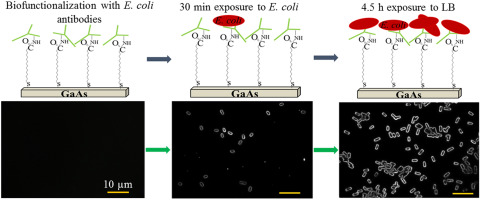Talanta ( IF 6.1 ) Pub Date : 2017-09-01 , DOI: 10.1016/j.talanta.2017.08.097 Elnaz Nazemi , Walid M. Hassen , Eric H. Frost , Jan J. Dubowski

|
Detection of pathogenic bacteria and monitoring their susceptibility to antibiotics are of great importance in the fields of medicine, pharmaceutical research, as well as water and food industries. In order to develop a photonic biosensor for detection of bacteria by taking advantage of photoluminescence (PL) of GaAs-based devices, we have investigated the capture and growth of Escherichia coli K12 on bare and biofunctionalized surfaces of GaAs (001) – a material of interest for capping different semiconductor microstructures. The results were compared with the capture and growth of Escherichia coli K12 on Au surfaces that have commonly been applied for studying a variety of biological and biochemical reactions. We found that neither GaAs nor Au-coated glass wafers placed in Petri dishes inoculated with bacteria inhibited bacterial growth in nutrient agar, regardless of the wafers being bare or biofunctionalized. However, the capture and growth of bacteria on biofunctionalized surfaces of GaAs and Au wafers kept in a flow cell and exposed to different concentrations of bacteria and growth medium revealed that the initial surface coverage and the subsequent bacterial growth were dependent on the biofunctionalization architecture, with antibody-coated surfaces clearly being most efficient in capturing bacteria and offering better conditions for growth of bacteria. We have observed that, as long as the GaAs wafers were exposed to bacterial suspensions at concentrations of at least 105 CFU/mL, bacteria could grow on the surface of wafers, regardless of the type of biofunctionalization architecture used to capture the bacteria. These results provide important insight towards the successful development of GaAs-based devices designed for photonic monitoring of bacterial reactions to different biochemical environments.
中文翻译:

大肠杆菌在GaAs(001)表面上的生长
在医学,药物研究以及水和食品工业领域,检测病原细菌并监测其对抗生素的敏感性非常重要。为了开发一种基于GaAs装置的光致发光(PL)的细菌探测光子生物传感器,我们研究了GaAs(001)的裸露表面和生物功能化表面上大肠杆菌K12的捕获和生长。封盖不同半导体微结构的兴趣。将结果与大肠杆菌的捕获和生长进行比较在金表面上的K12通常用于研究各种生物和生化反应。我们发现,放置在接种有细菌的培养皿中的GaAs或镀Au的玻璃威化饼都不会抑制细菌在营养琼脂中的生长,无论威化饼是裸露的还是经过生物功能化的。但是,在流通池中保留并暴露于不同浓度的细菌和生长介质的GaAs和Au晶片的生物功能化表面上细菌的捕获和生长表明,最初的表面覆盖率和随后的细菌生长取决于生物功能化结构,抗体包被的表面显然在捕获细菌方面最有效,并为细菌的生长提供了更好的条件。我们观察到,5 CFU / mL时,无论用于捕获细菌的生物功能结构的类型如何,细菌都可能在晶片表面生长。这些结果为成功开发基于GaAs的设备提供了重要的见识,这些设备设计用于对不同生化环境的细菌反应进行光子监测。



























 京公网安备 11010802027423号
京公网安备 11010802027423号